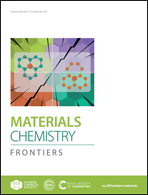Thiazoloisoindigo-based ambipolar polymers for excellent balanced hole and electron mobility†
Abstract
By taking advantage of both the appropriate electron-withdrawing capability and perfect linear coplanar molecular structure of chalcogenophene-flanked thiazoisoindigo (TzII) and thiophene-flanked dipyrrolopyrrolidone (DPP), four polymers with similar conjugated backbones, namely P(T-TzII-T-DPP)-C12, P(T-TzII-T-DPP)-C20, P(Se-TzII-T-DPP)-C12, and P(Se-TzII-T-DPP)-C20 were designed and synthesized, where T and Se stand for thiophene and selenophene and C12 and C20 stand for the length of the alkyl sidechain on DPP, respectively. All four polymers exhibit ideal linear coplanar backbones, rigidity of extended π-electron systems and suitable HOMO/LUMO energy levels favouring balanced ambipolar charge transport with the average μe/μh ratio ranging from 1.09 to 1.43. In particular, thin-film transistors made of a P(T-TzII-T-DPP)-C12 co-polymer exhibit the highest average electron (μe) and hole (μh) mobility of 6.29 and 5.77 cm2 V−1 s−1, respectively, and a well-balanced μe/μh ratio of 1.09. We also demonstrate that the sidechain length on DPP has a drastic influence of the backbone orientation of the polymers, where the polymers with a shorter C12 sidechain prefer to adopt an edge-on orientation while those with a C20 sidechain prefer to adopt mixed edge-on and face-on orientations after thermal annealing. Overall, this study demonstrates a simple yet effective approach to achieve high and well-balanced electron/hole mobility in organic transistors by combining the TzII unit and the DPP unit.



 Please wait while we load your content...
Please wait while we load your content...